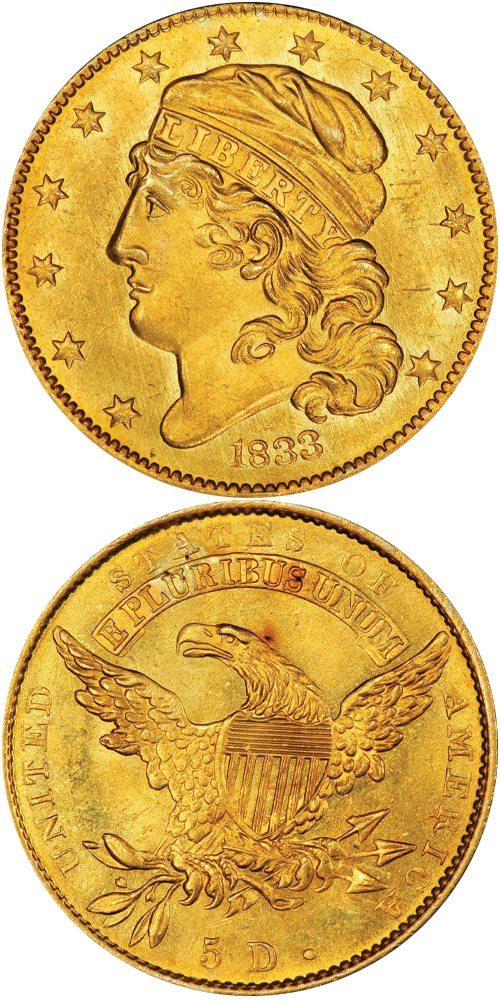1833 Capped Head Left Half Eagle
Small Date
Half eagles in the early years of the Mint were the workhorse denomination among gold coins. The quarter eagle was not popular in everyday use and seldom ordered and eagles had not been produced since 1804. Bolstered by supplies of gold coming from the Carolinas and Georgia, many thousands of John Reich"s Capped Head Left half eagles were produced at Philadelphia including 193,630 in 1833. Despite this large mintage, very few examples survive. It cost more than face value to strike each coin. Accordingly, they were valued as bullion items, not for face value. Nearly all were exported, mostly to Europe, where they were melted.
On June 28, 1834, Congress lowered the ratio of silver dollars to gold dollars from 16:1 to 15:1 to help bring a halt to the widespread hoarding and melting. Furthermore, on August 31, 1834, Congress also reduced the statutory fineness of the gold coinage from 0.9160 to 0.900 and reduced the weight for all denominations. For the half eagle, this meant a weight reduction from 8.75 grams to 8.36 grams. What few so-called "old tenor" gold coins that remained were actively withdrawn from circulation and received at the Mint at a rate of $5.32 per $5. They were then recoined into the lighter "new tenor" half eagles. As a result, very few Capped Head half eagles of any year survive and the series contains some of the most famous rarities of all United States coinage. None of the Capped Head Left half eagle issues may be considered common and for most collectors the addition of just a single example to their holdings is cause for celebration.
For the 1833 half eagle, a total of three varieties are known with two different date logotypes employed. The single Large Date variety has a rather blocky 8 in the date with a horizontal center bar, whereas the two Small Date variants employ a more script-like 8 punch last used in 1828, with a diagonal cross bar. Jeff Garrett and Ron Guth note that both varieties are of roughly equivalent scarcity with the Small Date being slightly rarer. Within the Small Date variant there are two known die pairings differing primarily in the placement of the period after the D in the denomination on the reverse. The Bass-Dannreuther 2 Distant Period variety is noted with Reverse State e, which proved to be terminal for this particular die, and can be distinguished by missing details on the eagle after having been relapped, and with fine cracks through (U)NITED and AMER(ICA). BD-2 is the less rare of the two Small Date variants but even then it is Rarity 6 with an estimated 22 to 28 specimens known in all grades. Fortunately, most of the surviving specimens are in relatively high grade.
The example to the left was sold by Stack's Bowers Galleries in the D. Brent Pogue Part IV Auction, where it realized $152,750.






